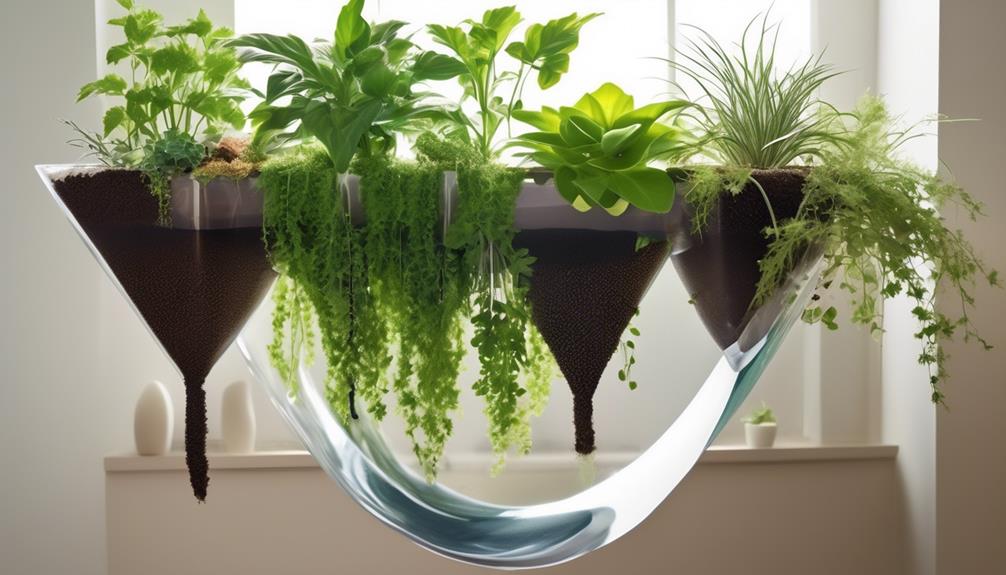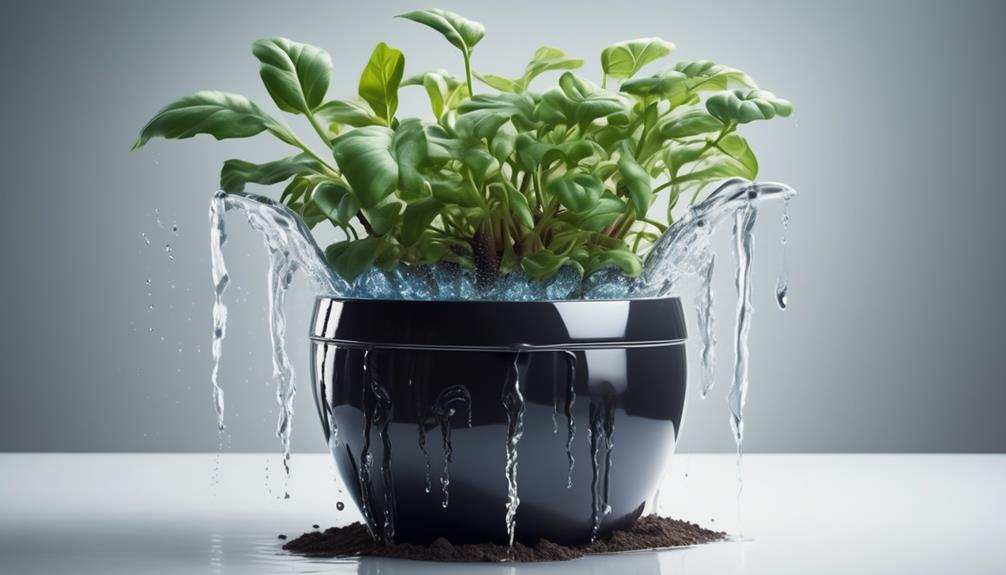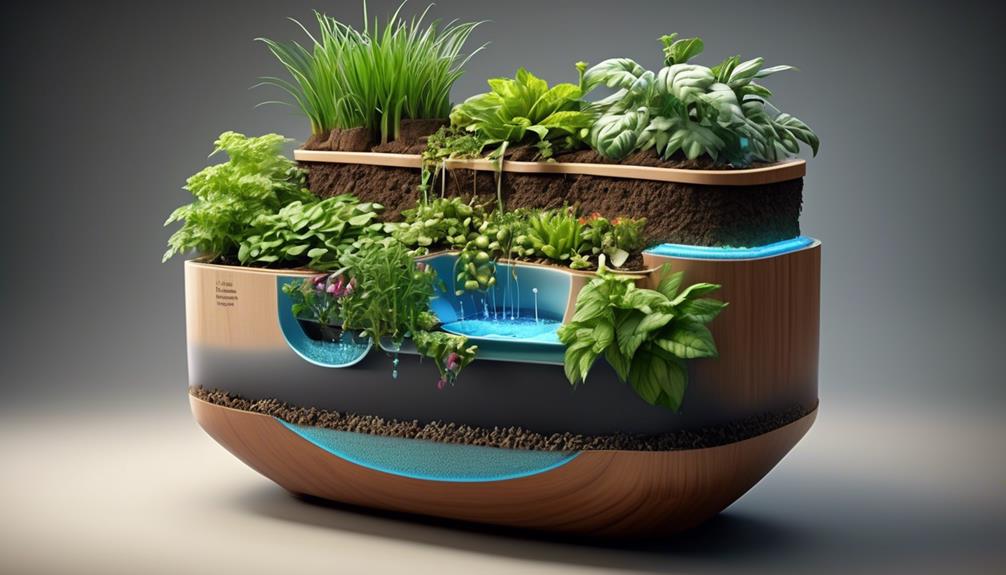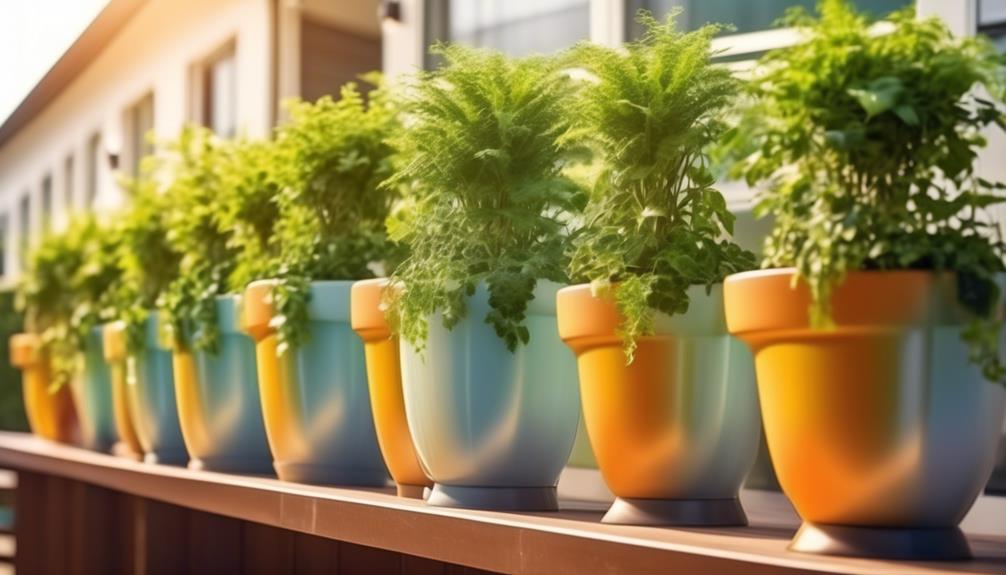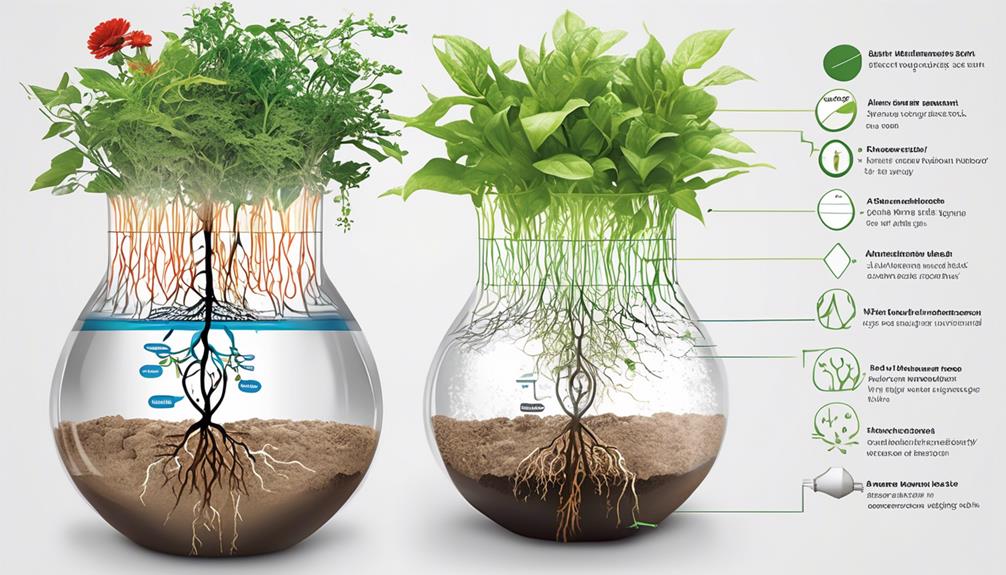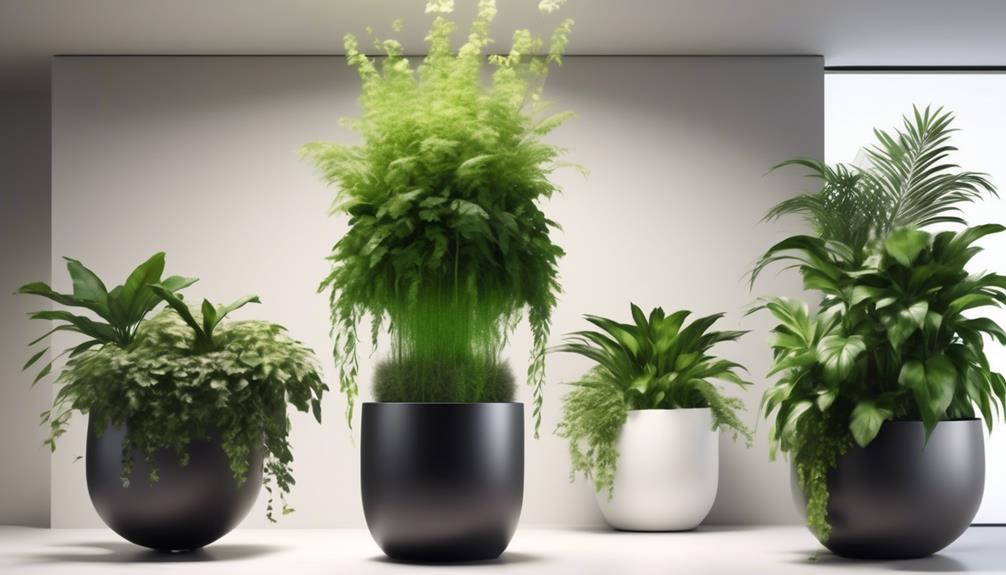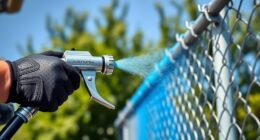Is it being proposed that there is a planter that can water itself? It might sound like something out of a sci-fi movie, doesn’t it? But the concept is not as unrealistic as it may seem. Self-watering planters are actually a thing and they are gaining popularity for several compelling reasons.
But before we get into that, let's unpack what exactly a self-watering planter is and how it works. Trust me, it's worth understanding.
Key Takeaways
- Self-watering planters utilize a reservoir system for consistent water supply.
- They are a convenient solution for container gardening in limited spaces.
- The built-in reservoir stores water for capillary action, reducing the frequency of watering and the risk of overwatering.
- Self-watering planters are beneficial for urban dwellers and frequent travelers as they provide constant moisture supply and reduce the need for frequent watering.
Understanding Self-Watering Planters
Self-watering planters utilize a reservoir system to provide a consistent water supply to the plants, ensuring optimal moisture levels for healthy growth.
In container gardening, especially in urban spaces, where outdoor space is limited, self-watering planters offer a convenient solution for growing indoor plants.
These innovative planters are designed with a built-in reservoir that stores water, allowing the plant to draw water up through the soil via capillary action. This mechanism ensures that the plant roots have access to water as needed, reducing the frequency of watering and the risk of overwatering, which is a common problem for indoor plants.
The convenience of self-watering planters is particularly beneficial for urban dwellers who may have limited time for plant care. The reservoir system helps maintain consistent moisture levels, promoting healthier plant growth and reducing the likelihood of water-related issues such as root rot.
Additionally, these planters can be an ideal choice for individuals who travel frequently or are new to gardening, as they provide a more forgiving environment for indoor plants.
How Self-Watering Planters Work
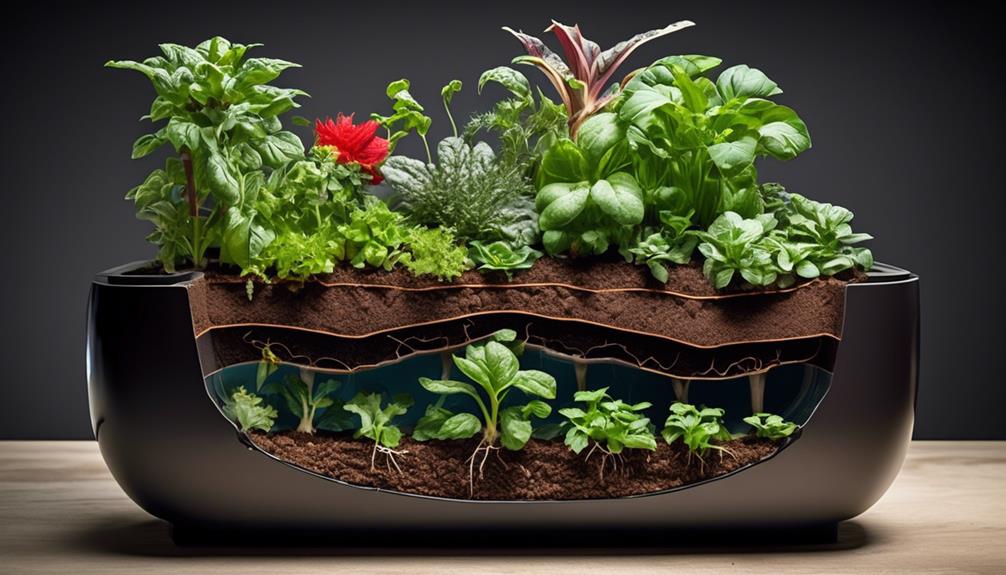
Self-watering planters work by utilizing a water reservoir to provide a constant supply of moisture to the plant's roots. This is achieved through the process of capillary action, where water is drawn up from the reservoir into the soil as needed.
As a result, the plant's roots remain consistently hydrated, promoting healthy growth and reducing the need for frequent watering.
Water Reservoir Function
With a built-in water reservoir, self-watering planters provide a consistent supply of moisture to the soil, ensuring optimal hydration for plants. The reservoir design plays a crucial role in the watering efficiency and overall plant growth. Here's how the water reservoir functions:
- Capillary Action: Water is drawn up from the reservoir into the soil through capillary action, maintaining a balanced moisture level.
- Aeration: The reservoir allows for proper aeration, preventing waterlogging and promoting healthy root growth.
- Water Distribution: Evenly distributes water throughout the soil, ensuring all roots have access to hydration.
- Moisture Monitoring: Some reservoirs come with indicators to signal when water levels are low, allowing for timely refills.
- Root Health: Maintains consistent moisture levels, promoting robust root development and overall plant health.
Capillary Action Process
Drawing water up from the reservoir into the soil through capillary action is a fundamental process that enables self-watering planters to maintain an optimal level of moisture for plant growth.
Capillary action, also known as capillarity, occurs when water moves through narrow spaces, such as the tiny gaps in the soil, due to the forces of adhesion and cohesion.
This process is crucial in self-watering planters as it allows the soil to remain consistently moist without becoming waterlogged.
Capillary action also plays a key role in hydroponic systems and passive irrigation, where it enables the movement of water to the plant roots without the need for pumps or complex watering systems.
Understanding the capillary action process is essential for designing and utilizing self-watering planters effectively to ensure proper soil moisture levels for healthy plant growth.
Plant Root Hydration
The process of capillary action, fundamental to the movement of water within self-watering planters, ensures efficient hydration of plant roots without reliance on external watering mechanisms. Plant root health greatly benefits from the efficient watering techniques facilitated by self-watering planters.
Here's how it works:
- Capillary action draws water from the reservoir into the soil, maintaining consistent moisture levels.
- The soil acts as a wick, distributing water evenly to the root zone.
- Excess water is stored in a reservoir, preventing waterlogging and root rot.
- Aeration through the soil prevents stagnation and promotes healthy root growth.
- The self-regulating system adapts to the plant's water needs, reducing the risk of under or overwatering.
Benefits of Self-Watering Planters
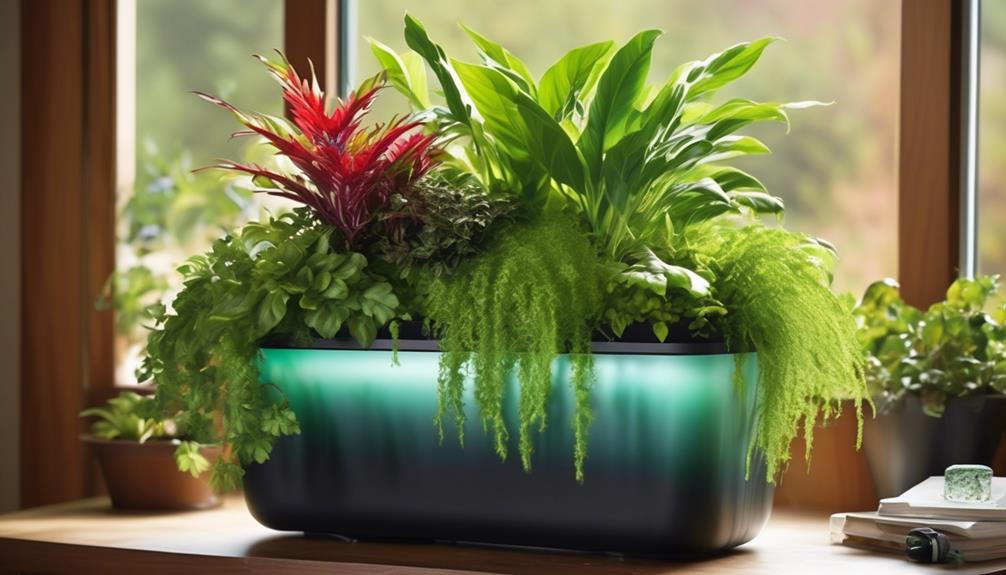
Self-watering planters offer several benefits, including water conservation and improved plant health. These planters utilize a reservoir system to deliver water directly to the roots, reducing water waste and promoting efficient hydration.
Water Conservation
Using a self-watering planter can significantly reduce the amount of water needed for plant maintenance. This promotes watering efficiency and enhances plant growth, making it an ideal choice for sustainable gardening, especially for indoor plants.
The water conservation benefits of self-watering planters are numerous:
- Reduced Water Usage: Self-watering planters deliver water directly to the plant's roots, minimizing evaporation and water wastage.
- Consistent Moisture Levels: These planters maintain consistent moisture levels, preventing overwatering and underwatering.
- Water Reservoir: The reservoir design ensures that water is utilized efficiently and only as needed by the plant.
- Environmental Impact: By conserving water, self-watering planters contribute to environmental sustainability.
- Time-Saving: They require less frequent watering, saving time and effort while promoting healthier plant growth.
Self-watering planters offer a practical solution for water-conscious gardeners, delivering optimal moisture levels for plants while conserving water resources.
Plant Health
Promoting efficient water usage and enhancing plant growth, self-watering planters also play a crucial role in maintaining optimal plant health. These planters ensure that plants receive consistent moisture, preventing issues such as overwatering or underwatering, which can lead to root rot or dehydration. By providing a constant supply of water, self-watering planters support the development of strong and healthy root systems, leading to improved plant growth and vitality. Additionally, these planters help in the efficient absorption of nutrients by the plants, further contributing to their overall health. The table below illustrates the key benefits of self-watering planters for plant health.
| Benefits of Self-Watering Planters for Plant Health |
|---|
| Consistent moisture levels |
| Prevention of over/underwatering |
| Strong and healthy root systems |
| Efficient nutrient absorption |
Choosing the Right Self-Watering Planter
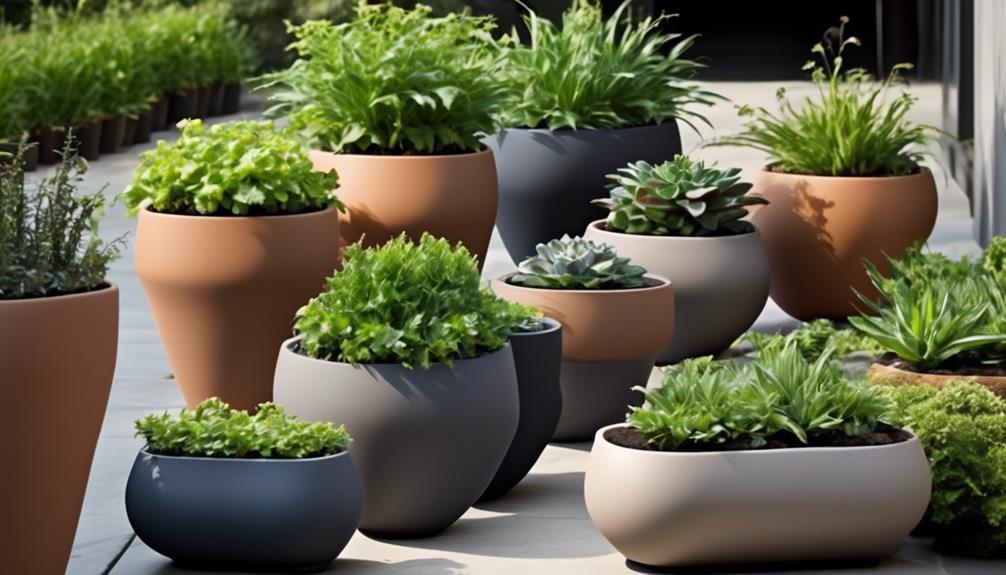
Selecting an appropriate self-watering planter depends on factors such as the type of plant, its water requirements, and the available space for the planter. When choosing the right self-watering planter, consider the following:
- Planter materials: Self-watering planters come in various materials such as plastic, ceramic, or terracotta. Each material has different insulation properties, affecting the soil's temperature and moisture levels. For example, plastic planters are lightweight and retain moisture well, while ceramic planters are sturdy and provide excellent insulation.
- Size options: Self-watering planters are available in different sizes to accommodate various plant types. Larger planters are suitable for shrubs and small trees, while medium-sized ones are ideal for flowers and herbs. Smaller planters are suitable for succulents and cacti.
- Water reservoir capacity: Consider the water reservoir capacity of the planter, as it directly impacts the frequency of watering. Planters with larger reservoirs require less frequent refilling, making them ideal for busy individuals or those with multiple plants.
- Aeration system: Some self-watering planters have built-in aeration systems that supply oxygen to the plant's roots. This feature is beneficial for promoting healthy root growth and preventing waterlogging.
- Aesthetic appeal: Lastly, consider the aesthetic appeal of the planter. Choose a design that complements the plant and enhances the overall visual appeal of the space.
Maintaining Self-Watering Planters

To ensure optimal performance of self-watering planters, it is essential to regularly inspect the water reservoir and drainage system. The water reservoir should be checked and refilled as needed, following a consistent watering schedule based on the specific needs of the plants. This is crucial for maintaining the health and vitality of the plants.
Additionally, the drainage system should be inspected to ensure it is clear of any debris or blockages that may impede proper water flow. Regular maintenance of self-watering planters also involves monitoring the planter material for any signs of wear or damage. This is important for both the functionality and aesthetics of the planter.
Planter materials can vary from plastic to ceramic, and each requires specific care to maintain its appearance and functionality over time. Cleaning the planter periodically can help prevent the build-up of mineral deposits or algae, preserving its visual appeal.
Creative Uses for Self-Watering Planters
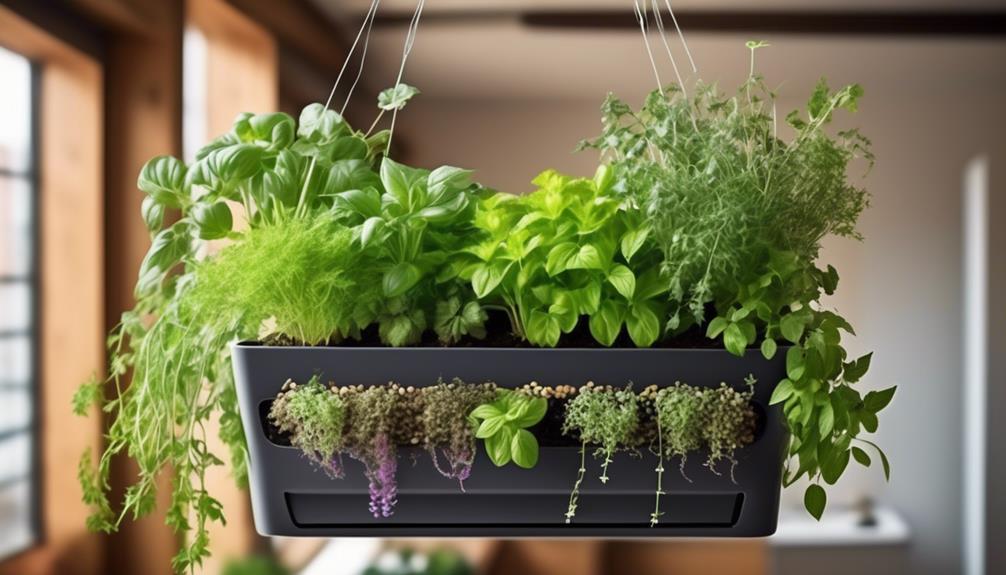
Regular maintenance of self-watering planters ensures their optimal performance and also opens up opportunities for creative uses that go beyond traditional plant care. When it comes to creative uses for self-watering planters, the possibilities are endless. Here are five innovative ways to utilize self-watering planters:
- Indoor Herb Garden: Transform your self-watering planters into a convenient and thriving indoor herb garden. Place them on your kitchen windowsill or countertop to have fresh herbs at your fingertips for cooking.
- Apartment Gardening: Utilize self-watering planters for apartment gardening, especially if you have limited outdoor space. You can grow a variety of plants, flowers, or even small vegetables on your balcony or patio.
- Vertical Planting: Create a stunning vertical garden using self-watering planters. Stack them up on a wall or hang them from a railing to maximize space and add a touch of greenery to your surroundings.
- Office Greenery: Bring nature into your workspace by using self-watering planters to cultivate a mini garden on your desk or in the office common area. It's a refreshing way to enhance the indoor environment.
- Creative Plant Displays: Use self-watering planters to craft unique and eye-catching plant displays. Experiment with different planter sizes, shapes, and arrangements to create visually appealing compositions in your home or office.
Frequently Asked Questions
How Long Do Self-Watering Planters Typically Last Before Needing to Be Replaced?
Self-watering planters typically last for several years before needing replacement. Pros include consistent moisture levels and reduced watering frequency. However, cons may include the need for occasional cleaning and maintenance.
To maximize longevity, regularly check the planter for clogs, clean the reservoir, and ensure proper drainage. Following these maintenance tips can help extend the lifespan of your self-watering planter.
Can Self-Watering Planters Be Used for All Types of Plants, Including Succulents and Cacti?
Self-watering planters are great for a variety of plants, including succulents and cacti. They offer numerous benefits, such as consistent moisture levels and reduced watering frequency.
However, they may not be suitable for plants that prefer drier conditions. Maintenance involves monitoring water levels and occasional troubleshooting for clogs or malfunctions.
Despite some drawbacks, self-watering planters can be a convenient and efficient option for many types of plants.
Are Self-Watering Planters Suitable for Outdoor Use in Extreme Weather Conditions?
In extreme weather conditions, self-watering planters display remarkable outdoor durability. Their innovative design ensures that they can withstand harsh weather, providing reliable protection for plants.
These planters are engineered to resist extreme weather, making them suitable for outdoor use in various climates. Whether it's scorching heat or freezing cold, self-watering planters offer the necessary stability and resilience for plants to thrive, even in the most challenging outdoor environments.
Can Self-Watering Planters Be Connected to a Drip Irrigation System for Added Convenience?
Yes, self-watering planters can be connected to a drip irrigation system, offering benefits like efficient water distribution and reduced maintenance.
The system's drawbacks include initial installation costs and potential clogging issues.
However, it provides an effective, cost-efficient option for maintaining planters, especially in extreme weather conditions.
Do Self-Watering Planters Require Any Special Type of Soil or Fertilizer for Optimal Plant Growth?
We've found that special soil isn't always necessary for self-watering planters, but it can certainly benefit plant growth. These planters provide a consistent moisture level, which can affect the type of soil and fertilizer needed for optimal growth.
The soil should be well-draining yet able to retain moisture, and the fertilizer should be balanced to support healthy root development.
This combination supports the unique watering system of self-watering planters for thriving plants.
Can I Use a Self Watering Planter for All Types of Plants?
Yes, you can use a self watering planter for all types of plants. The key to success lies in understanding the self watering planter functionality. By adjusting the watering schedule and choosing the right soil, you can provide the optimal growing conditions for any plant in a self watering planter.
Conclusion
In conclusion, self-watering planters are a game-changer for anyone looking to simplify their plant care routine.
With their built-in reservoirs and capillary action, these planters provide consistent moisture to your plants without the hassle of daily watering.
They're a real 'set it and forget it' solution for busy gardeners.
Whether you're growing herbs, flowers, or vegetables, self-watering planters are a smart choice for healthy and thriving plants.

